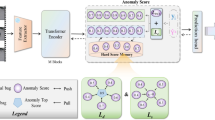Abstract
Most research on anomaly detection has focused on event that is different from its spatial–temporal neighboring events. However, it is still a significant challenge to detect anomalies that involve multiple normal events interacting in an unusual pattern. To address this problem, a novel semi-supervised method based on sparse topic model is proposed to detect anomalies in video surveillance. Short local trajectory method is used to extract motion information in order to improve the robustness of trajectories. For the purpose of strengthening the relationship of interest points on the same trajectory, the Fisher kernel method is applied to obtain the representation of trajectory which is quantized into visual word. Then, the sparse topic model is proposed to explore the latent motion patterns and achieve a sparse representation for the video scene. Finally, a semi-supervised learning method is applied to enhance the discrimination of model and improve the performance of anomaly detection. Experiments are conducted on QMUL dataset and AVSS dataset. The results demonstrated the superior efficiency of the proposed method.





Similar content being viewed by others
Change history
16 July 2024
This article has been retracted. Please see the Retraction Notice for more detail: https://doi.org/10.1007/s00521-024-10082-9
References
Leyva R, Sanchez V, Li C (2015) Video anomaly detection based on wake motion descriptors and perspective grids. In: IEEE international workshop on information forensics and security. IEEE, pp 209–214
Piciarelli C, Foresti GL (2010) Surveillance-oriented event detection in video streams. IEEE Intell Syst 26(3):32–41
Cong Y, Yuan J, Liu J (2011) Sparse reconstruction cost for abnormal event detection. In: IEEE conference on computer vision and pattern recognition. IEEE Computer Society, pp 3449–3456
Ren H, Moeslund TB (2014) Abnormal event detection using local sparse representation. In: IEEE international conference on advanced video and signal based surveillance. IEEE, pp 125–130
Xia LM, Yang BJ, Tu HB (2015) Recognition of suspicious behavior using case-based reasoning. J Cent South Univ 22(1):241–250
Roshtkhari MJ, Levine MD (2013) Online dominant and anomalous behavior detection in videos. In: Computer vision and pattern recognition. IEEE, pp 2611–2618
Biswas S, Barur V (2015) Sparse representation based anomaly detection with enhanced local dictionaries. In: IEEE international conference on image processing. IEEE, pp 5532–5536
Cui X, Liu Q, Gao M et al (2011) Abnormal detection using interaction energy potentials. In: Computer vision and pattern recognition. IEEE, pp 3161–3167
Bera A, Kim S, Manocha D (2016) Realtime anomaly detection using trajectory-level crowd behavior learning. In: IEEE conference on computer vision and pattern recognition workshops. IEEE Computer Society, pp 1289–1296
Cheng KW, Chen YT, Fang WH (2015) Gaussian process regression-based video anomaly detection and localization with hierarchical feature representation. IEEE Trans Image Process 24(12):5288–5301
Yang C, Yuan J, Ji L (2011) Sparse reconstruction cost for abnormal event detection. In: IEEE conference on computer vision & pattern recognition, pp 3449–3456
Guo K, Ishwar P, Konrad J (2010) Action recognition using sparse representation on covariance manifolds of optical flow. In: IEEE international conference on advanced video & signal based surveillance. IEEE Computer Society, pp 188–195
Mo X, Monga V, Bala R et al (2014) Adaptive sparse representations for video anomaly detection. IEEE Trans Circuits Syst Video Technol 24(4):631–645
Kaviani R, Ahmadi P, Gholampour I (2014) Incorporating fully sparse topic models for abnormality detection in traffic videos. In: International conference on computer and knowledge engineering. IEEE, pp 586–591
Emonet R, Varadarajan J, Odobez JM (2011) Extracting and locating temporal motifs in video scenes using a hierarchical non parametric bayesian model. In: Computer vision and pattern recognition. IEEE, pp 3233–3240
Yoo Y, Yun K, Yun S et al (2016) Visual path prediction in complex scenes with crowded moving objects. In: Computer vision and pattern recognition. IEEE, pp 2668–2677
Fu W, Wang J, Lu H et al (2013) Dynamic scene understanding by improved sparse topical coding. Pattern Recogn 46(7):1841–1850
Wang J, Fu W, Lu H et al (2014) Bilayer sparse topic model for scene analysis in imbalanced surveillance videos. IEEE Trans Image Process 23(12):5198–5208
Jeong H, Yoo Y, Yi KM et al (2014) Two-stage online inference model for traffic pattern analysis and anomaly detection. Mach Vis Appl 25(6):1501–1517
Pathak D, Sharang A, Mukerjee A (2015) Anomaly localization in topic-based analysis of surveillance videos. In: IEEE winter conference on applications of computer vision. IEEE Computer Society, pp 389–395
Wang H, Klaser A, Schmid C et al (2013) Dense trajectories and motion boundary descriptors for action recognition. Int J Comput Vis 103(1):60–79
Perronnin F, Nchez J, Mensink T (2010) Improving the fisher kernel for large-scale image classification. In: European conference on computer vision. Springer, pp 143–156
Perronnin F, Dance C, Csurka G et al (2006) Adapted vocabularies for generic visual categorization. In: European conference on computer vision. Springer, pp 464–475
Eltoft T, Kim T, Lee TW (2006) On the multivariate Laplace distribution. IEEE Signal Process Lett 13(5):300–330
Acknowledgments
This work was supported by the National Natural Science Foundation of China (Grant No. 51678075), the Science and Technology Project of Hunan (Grant No. 2017GK2271), the Hunan Provincial Natural Science Foundation of China (Grant No.2017JJ2015).
Author information
Authors and Affiliations
Corresponding author
Ethics declarations
Conflict of interest
The authors declare that there is no conflict of interests regarding the publication of this paper (such as financial gain).
Additional information
This article has been retracted. Please see the retraction notice for more detail:https://doi.org/10.1007/s00521-024-10082-9
Rights and permissions
Springer Nature or its licensor (e.g. a society or other partner) holds exclusive rights to this article under a publishing agreement with the author(s) or other rightsholder(s); author self-archiving of the accepted manuscript version of this article is solely governed by the terms of such publishing agreement and applicable law.
About this article
Cite this article
Wang, J., Xia, L., Hu, X. et al. RETRACTED ARTICLE: Abnormal event detection with semi-supervised sparse topic model. Neural Comput & Applic 31, 1607–1617 (2019). https://doi.org/10.1007/s00521-018-3417-1
Received:
Accepted:
Published:
Issue Date:
DOI: https://doi.org/10.1007/s00521-018-3417-1




